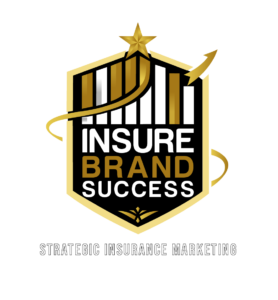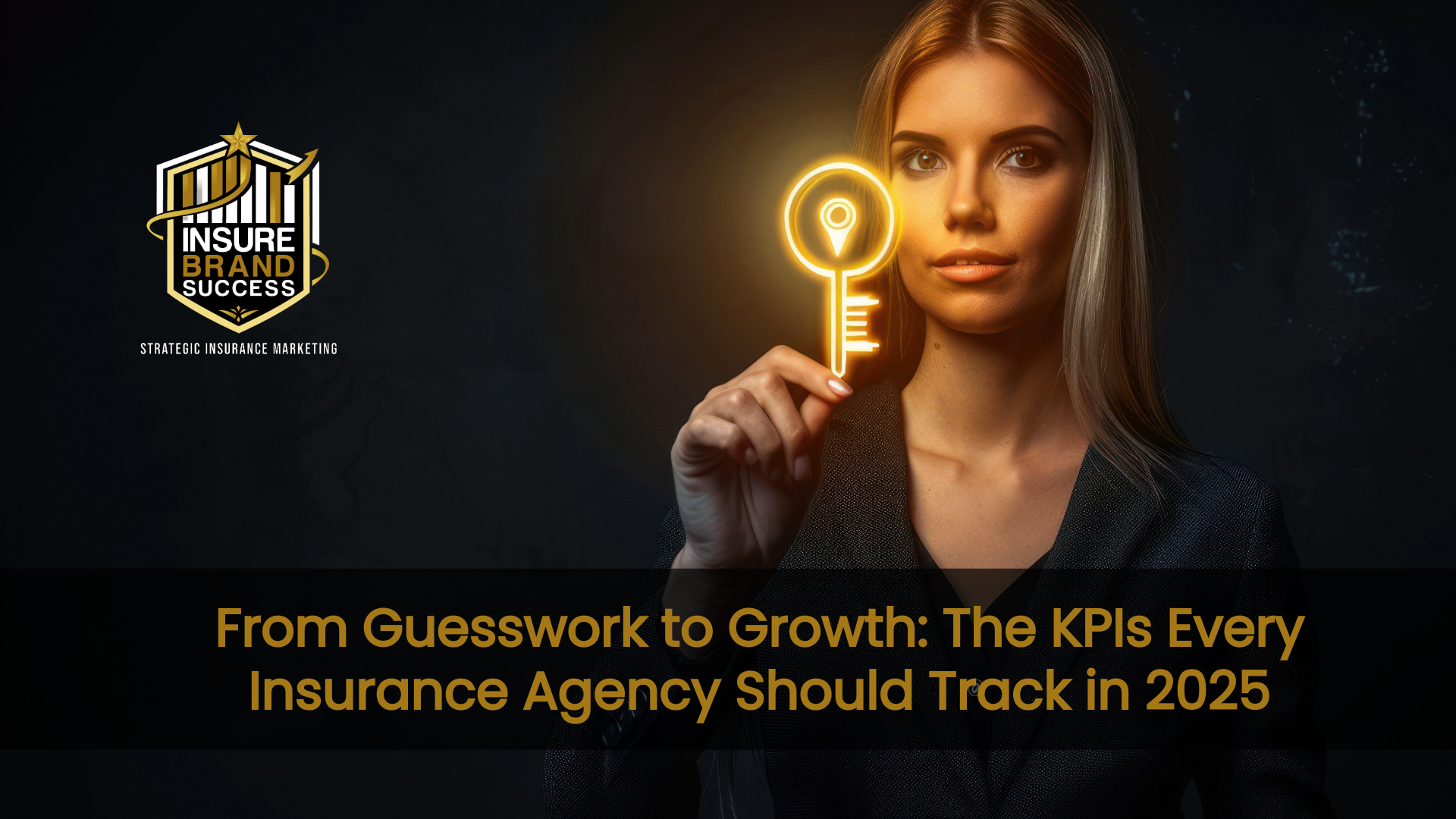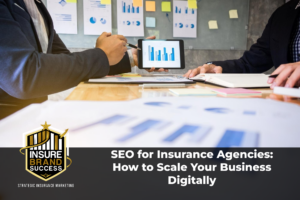Data-Driven Growth: Why Metrics Matter More Than Ever
In today’s hyper-competitive market, insurance agencies can no longer afford to “hope” their marketing works. Success isn’t about gut instinct—it’s about tracking the right data. Yet, many firms still focus on vanity metrics that look good in a report but don’t translate into revenue.
At Insure Brand Success, we believe data is the foundation of every high-performing insurance marketing strategy. Whether you’re investing in digital marketing for insurance agencies, testing out AdWords for insurance agencies, or launching a brand-new website, the real question is: Are you measuring what matters? The agencies that win consistently are the ones that track outcomes—not just activity.
And that’s where most insurance firms fall short. They might know their website traffic or social media followers, but they can’t tell you their cost per lead, quote-to-close ratio, or retention rate. Those are the metrics that predict sustainable growth. They guide strategic decisions, fuel client acquisition, and reveal exactly where to invest next. In this article, we’ll break down the 7 marketing metrics that actually matter—and show you how to use them to drive predictable, profitable growth in your agency.
1. Cost Per Lead (CPL)
Cost Per Lead (CPL) is one of the most crucial metrics for insurance agencies looking to evaluate the effectiveness of their marketing efforts. CPL tells you exactly how much you’re spending to generate a single lead—regardless of whether that lead converts. When analyzed consistently, it serves as a barometer for the efficiency of your marketing campaigns across different channels like paid search, social media, and content marketing.
Agencies that don’t track CPL are essentially flying blind. It’s easy to get distracted by metrics like impressions and clicks, but if those interactions don’t translate into actual leads—and eventually customers—they’re not contributing to your bottom line. CPL allows you to quantify the value of your marketing dollar. For example, if you’re running a campaign with a budget of $1,000 and you acquire 25 leads, your CPL is $40. By benchmarking this across campaigns and channels, you can identify which strategies are performing best and where to reallocate spend.
When working with platforms like Google Ads or Meta Ads, understanding your CPL also enables you to make smarter bidding and targeting decisions. For instance, an agency might find that leads from a hyper-targeted LinkedIn campaign cost more but convert at a higher rate, making them more valuable in the long run. Paired with tools like CRM systems and call tracking software, CPL becomes even more powerful, offering granular insights into which campaigns are worth scaling and which should be paused or optimized.
At Insure Brand Success, we emphasize the importance of CPL in every engagement. When CPL is monitored alongside other core metrics like customer acquisition cost (CAC) and lead-to-quote conversion rate, agencies are empowered to grow sustainably and confidently.
📌 For agencies using AdWords for insurance agencies, this number is critical for real-time campaign decisions.
2. Lead-to-Quote Conversion Rate
The Lead-to-Quote Conversion Rate is the percentage of leads that progress to the quoting stage. This metric measures the quality of your leads and the effectiveness of your marketing message in attracting the right audience. It’s one thing to generate leads—it’s another to ensure those leads are interested, qualified, and actively seeking insurance solutions.
This metric is particularly useful for agencies because it connects marketing and sales performance. A high number of leads with a low lead-to-quote conversion rate could indicate that your campaigns are attracting unqualified prospects. For example, running broad-targeting campaigns might get your form submissions up, but if most of those contacts aren’t homeowners when you’re selling home insurance, your quote rate will be low—and your sales team frustrated.
A healthy lead-to-quote conversion rate varies by insurance type and market segment, but for most agencies, anything in the range of 20–35% is a good benchmark. If your rate is below 20%, you might need to revisit your ad copy, landing page messaging, or targeting settings. Agencies that implement tailored insurance SEO services often see an improvement in this metric because inbound leads from organic search tend to be more intentional and informed.
At Insure Brand Success, we help agencies identify these bottlenecks. We often recommend refining audience segmentation, deploying lead qualification questions, or even integrating automated pre-screening tools that boost quote-readiness. The goal is to ensure your sales team spends more time with high-intent prospects—ultimately leading to faster conversions and higher ROI.

3. Quote-to-Close Ratio
Once a lead is quoted, the next step is closing the deal. The Quote-to-Close Ratio tells you how many quoted prospects actually become paying policyholders. This metric is often seen as a reflection of sales performance, but it also highlights how well your marketing and messaging align with the actual offerings of your agency.
For example, if your marketing promotes ultra-competitive pricing but your quoted premiums are higher due to underwriting factors, you may lose trust and see a drop in close rates. Similarly, if you’re attracting leads who aren’t truly ready to buy, your agents will waste time quoting policies that don’t close. Tracking this ratio ensures your funnel is well-aligned from the first ad impression to the final signature.
A strong quote-to-close ratio generally ranges from 30–50%, depending on the insurance product and level of market competition. Anything lower than 25% may indicate disconnects between prospect expectations and your actual offer—or issues with the follow-up process. In our work with agencies, we often find that implementing a follow-up cadence (e.g., emails, calls, and SMS reminders) can significantly boost this ratio.
Advanced CRM tools allow you to monitor this metric by agent, campaign, or region. Pairing these insights with structured client acquisition and retention programs can help your team refine their approach and tailor messaging to each client persona. Agencies that consistently track and improve this ratio tend to scale faster and generate more referrals due to higher client satisfaction and smoother onboarding.
4. Customer Acquisition Cost (CAC)
Customer Acquisition Cost (CAC) is the total cost of acquiring a new client, including both marketing and sales expenses. It’s one of the most comprehensive performance metrics and plays a critical role in determining the sustainability and profitability of your agency’s growth efforts. Unlike CPL, which focuses solely on lead generation, CAC incorporates all touchpoints—ads, sales calls, nurturing emails, and even overhead—to provide a complete picture of your investment.
To calculate CAC, divide your total spend on marketing and sales over a period by the number of new customers acquired during that same time. For example, if your agency spends $10,000 on digital campaigns, email outreach, and sales commissions in a quarter and acquires 100 new clients, your CAC is $100. When compared against your average policy revenue or Customer Lifetime Value (CLV), this metric shows whether your campaigns are building a profitable foundation.
This is where working with a strategic partner like Insure Brand Success becomes invaluable. We help agencies lower CAC by optimizing each stage of the funnel—from ad targeting and insurance email marketing to landing page design and follow-up automation. Small tweaks like segmenting audiences, improving ad relevance, or using remarketing strategies can dramatically reduce CAC while improving lead quality.
🔍 Tracking this alongside client acquisition and retention programs shows whether your growth is sustainable.
Pro Tip: Compare CAC to Customer Lifetime Value (CLV) to ensure long-term profitability.
5. Retention Rate / Policy Renewal Rate
While many insurance agencies obsess over acquiring new clients, the most profitable firms know that retention is where true growth happens. Policy renewals are a powerful predictor of long-term success and revenue stability. This metric—whether tracked as customer retention rate or policy renewal percentage—reveals how well your agency maintains client relationships over time.
High retention rates are a strong indicator of customer satisfaction and trust. Conversely, a drop in renewals could signal pricing issues, poor service, or a weak post-sale experience. According to the Insurance Information Institute, clients who don’t feel engaged or supported after the initial sale are significantly less likely to renew—regardless of price. That means your post-sale strategy is just as important as your acquisition funnel.
Improving this metric requires intentional communication. One of the most effective strategies is implementing a targeted insurance email marketing campaign that keeps your brand top-of-mind throughout the policy lifecycle. Reminders, check-ins, coverage education, and value-add emails build trust and reduce churn.
At Insure Brand Success, we help agencies develop client acquisition and retention programs that include automated touchpoints and personalized engagement. These efforts not only improve renewal rates but also increase referrals, upsells, and lifetime customer value—creating a compounding effect that fuels sustainable agency growth.

6. Organic Search Visibility & Branded Search Volume
In the digital age, a strong online presence is essential for client acquisition. One of the most overlooked metrics in insurance marketing is organic search visibility—how often your website appears in search results for relevant keywords. Combined with branded search volume (the number of times your agency’s name is searched directly), this data reflects your brand authority and discoverability.
Why does this matter? Because more than 70% of consumers begin their insurance research online. If your agency isn’t showing up when people search for “auto insurance in [your city]” or “independent broker near me,” you’re missing a massive opportunity. And if no one is searching for your brand name, that’s a red flag that your awareness campaigns need work.
We recommend using tools like Google Search Console, SEMrush, or Ahrefs to monitor key performance indicators such as:
- Impressions for core keywords
- Rankings for service-related terms
- Branded vs. non-branded search trends
- Organic traffic to landing pages
Agencies that invest in SEO for insurance brokers and SEO solutions for insurance see dramatic increases in both organic traffic and branded search volume within 60–90 days. This is because search visibility builds trust—even before a prospect clicks.
As the Small Business Administration emphasizes, a strong digital presence backed by SEO is one of the most powerful marketing strategies available to small businesses, including insurance firms.
At Insure Brand Success, we don’t just help you rank—we help you dominate your local market with content, backlinks, and technical SEO that turn traffic into leads.
📈 Agencies using SEO for insurance brokers and SEO solutions for insurance often see measurable traffic lifts within 60–90 days.
Authoritative Insight: The Small Business Administration lists SEO and content visibility as top digital growth tools.
7. Engagement Rate (Social & Email)
Engagement Rate reflects how actively your audience interacts with your content. It goes beyond surface metrics like impressions or reach and offers a deeper look into how well your messaging resonates.
While often labeled a “soft metric,” engagement is a leading indicator of brand trust, relevance, and conversion potential. In an industry built on relationships, attention is a currency—and engagement is how you measure it.
Key engagement metrics to track:
- Email Open Rate: Target 25–35% to ensure subject lines and send times are effective.
- Email Click-Through Rate (CTR): A healthy benchmark is 2–5%; this indicates your content is compelling and actionable.
- Social CTR: Aim for 1–2% depending on the platform and ad format.
- Post Interactions: Track likes, comments, shares, and saves—these signal how relevant and valuable your content is.
- Video Views/Watch Time: Great for platforms like Facebook, Instagram, and YouTube—higher watch time often equals higher trust.
Why engagement matters:
- 🔍 Predictive of conversion: High engagement often precedes high conversion.
- 💬 Builds community: Engaged users are more likely to refer others and become long-term clients.
- 📈 Improves algorithm reach: Platforms like Meta and LinkedIn show your content to more people when engagement is high.
- 🧠 Guides content strategy: Insights from engagement trends help you refine topics, formats, and timing.
Pro tip: Agencies using social media strategies that include targeted content, consistent posting, and performance tracking often see a steady increase in both engagement and leads.
At Insure Brand Success, we help you turn passive followers into active brand advocates—because in insurance, engagement isn’t optional. It’s essential.

Bonus Metric: Revenue by Channel
Tracking revenue by marketing channel—especially digital versus traditional—lets you double down on what’s working.
💡 One Insure Brand Success client reallocated 30% of their traditional ad budget to digital channels after identifying a 3.5x ROI from email and AdWords combined.
From Data to Action: Implementing These Metrics
Knowing these KPIs isn’t enough—you need to integrate them into daily operations.
✔️ Use Dashboards
Connect Google Analytics, your CRM, and ad platforms into one cohesive view. Tools like Databox or Google Looker Studio help visualize performance.
✔️ Set Benchmarks
Use industry benchmarks and historical agency data to set goals. Reference industry reports from the National Association of Insurance Commissioners for compliance-adjusted benchmarks.
✔️ Audit Regularly
Hold monthly or quarterly reviews with your marketing team or agency partner. Adjust strategy as trends emerge.
Let’s Build Smarter Growth Together
Tracking the right marketing metrics isn’t just a best practice—it’s a business imperative. Data-driven agencies outperform their competitors because they don’t just guess what’s working—they know. When your team can clearly see what channels are driving qualified leads, what campaigns are delivering ROI, and where clients are falling off in the funnel, you unlock the ability to scale with confidence.
At Insure Brand Success, we don’t just give you the data—we help you act on it. Our tailored marketing solutions are built specifically for insurance agencies and brokerages that want to improve performance across every stage of the customer journey. From digital marketing for insurance agencies and website design to client acquisition and retention programs, we deliver proven systems that align with your goals—and your metrics.
Whether you’re looking to increase lead volume, improve conversion rates, retain more clients, or expand your brand visibility, our team has the expertise and industry insight to help you get there faster. We believe smarter marketing starts with smarter measurement—and we’re here to guide you every step of the way.
Ready to turn data into growth?
Download for FREE the Success Tracking Template and track what matters!
Contact us today to schedule your strategy session and see how Insure Brand Success can help you reach the next level.




